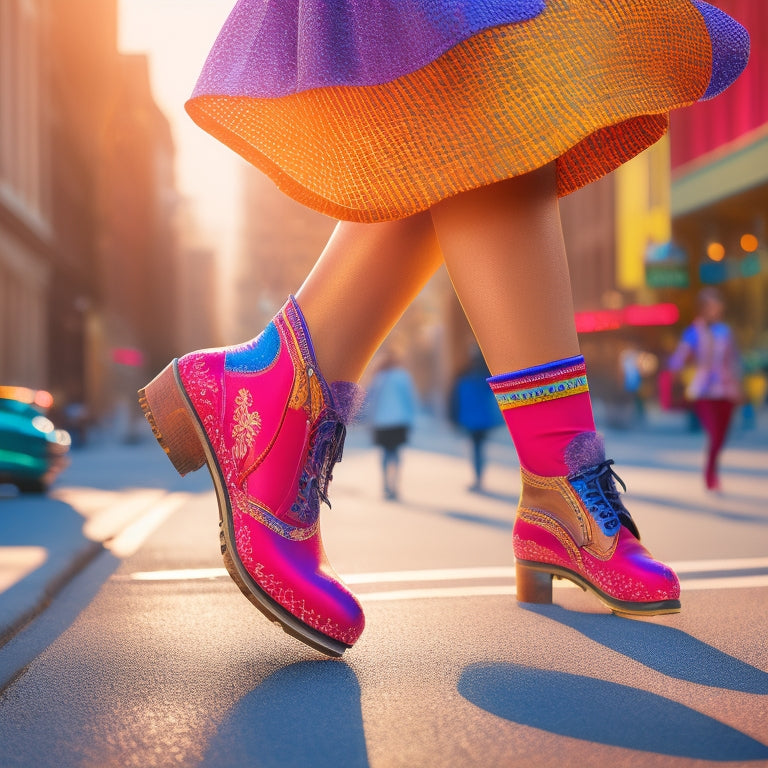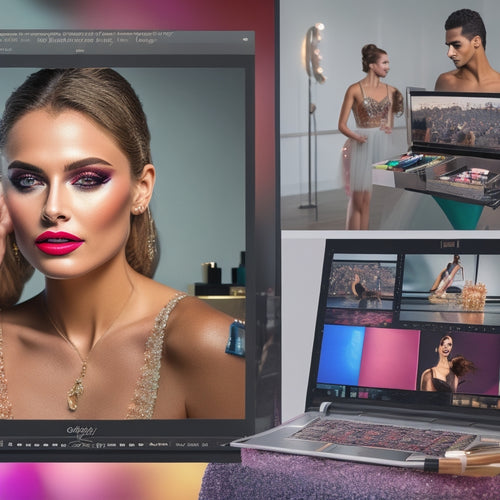
Can You Walk With Tap Shoes?
Share
You can walk with tap shoes, but it's important to take into account their design features, weight distribution, and traction. Proper alignment and posture are vital for balance and control. The innovative tread pattern and grooves provide exceptional traction, and contoured soles offer stability. Don't forget to take into account the noise level, especially on hardwood floors. With the right technique and shoes, you can move confidently. As you explore the world of tap shoes, you'll discover more about what makes them tick and how to get the most out of your experience.
Key Takeaways
• Tap shoes are designed for dancing, not walking, and may not provide the necessary support or traction for everyday walking.
• The metal plates on the ball and heel of tap shoes can make walking difficult and noisy.
• Tap shoes often have a low-cut profile and soft upper, which can compromise ankle stability while walking.
• The weight and balance of tap shoes are designed for dance movements, not walking, and may affect your posture and gait.
• While you can walk with tap shoes, it's not recommended, as it may cause discomfort, affect your balance, and potentially lead to injuries.
Design and Structural Differences
When you slip on a pair of tap shoes, you're stepping into a world of rhythmic expression, where the design and structural differences between tap shoes and regular shoes become essential to mastering the art of tap dancing.
The material selection for tap shoes is vital, as it affects the sound quality and durability of the shoes. Typically, metal plates are attached to the ball and heel of the shoe, which produce the distinctive 'tap' sound. The shoes themselves are often made of leather or synthetic materials, chosen for their flexibility and support.
Ankle flexibility is also important, as it allows for a greater range of motion and control. Look for shoes with a low-cut profile and a soft, pliable upper to guarantee maximum flexibility and comfort.
With the right tap shoes, you'll be well on your way to creating your own rhythmic magic.
Weight and Balance Factors
As you step into your tap shoes, you'll want to focus on the weight and balance factors that'll make or break your rhythm.
It's important to take into account how your body weight is distributed, where your center of gravity lies, and how you align your heels and toes - all of which will greatly impact your overall balance and movement.
Heel-Toe Alignment Matters
Proper heel-toe alignment is essential in tap dancing, as it directly affects your weight distribution and balance, enabling you to execute movements with precision and control.
When your heels and toes are in alignment, you'll maintain good posture, which is vital for balance and overall technique.
To achieve proper alignment, focus on correcting your posture through exercises that strengthen your core and improve your overall posture.
As you practice, your muscle memory will kick in, and you'll find yourself automatically adjusting your alignment.
Remember, it's all about creating a strong foundation, so take your time, and don't be afraid to slow down and focus on perfecting your heel-toe alignment.
With consistent practice, you'll be tapping your way to success in no time!
Body Weight Distribution
You'll find that maintaining ideal body weight distribution is essential for executing tap steps with precision and control, as even slight imbalances can throw off your entire rhythm.
As you practice, focus on distributing your weight evenly between both feet, with a slight emphasis on the balls of your feet. This will help you maintain balance and generate kinetic flow in your movements.
Remember to keep your posture corrected, with your shoulders relaxed and your core engaged. This will allow you to move with fluidity and precision, effortlessly shifting between steps.
Center of Gravity
Your center of gravity is the key to revealing smooth, balanced movements, and it's directly tied to your weight distribution, which you've been refining through practice.
As you walk with tap shoes, your core stability plays an essential role in maintaining balance points. When your center of gravity is aligned with your weight distribution, you'll feel more grounded and stable. This, in turn, allows you to move with confidence and poise.
Focus on engaging your core muscles to support your movements, and you'll notice a significant improvement in your overall balance and control. By refining your center of gravity, you'll be able to execute complex tap steps with ease and precision, making your performances truly shine.
Traction and Grip Capabilities
As you step out onto the floor, the tap shoes' innovative tread pattern and strategically placed grooves work in tandem to provide exceptional traction and grip capabilities, keeping you confidently grounded.
The contoured sole curves cradle your foot, while the heel catches provide additional stability, ensuring you can move with precision and control.
With every step, the shoes' clever design grips the floor, giving you the confidence to take on any routine.
Whether you're tapping out a rhythm or simply walking across the room, you'll appreciate the shoes' ability to keep you firmly planted.
Comfort and Support Features
With every step, the shoes' cushioned insoles and breathable mesh panels work together to envelop your feet in comfort, providing superior arch support and alleviating pressure points.
You'll appreciate the attention to detail in the design, crafted to make walking in tap shoes a breeze.
Here are some key comfort and support features to look forward to:
-
Customizable arch support: Get the perfect fit with adjustable arch supports that mold to your foot shape.
-
Cushioning systems: Softer landings and reduced impact on your joints mean you can dance the day away.
-
Moisture-wicking materials: Keep your feet cool and dry, even during the most intense performances.
- Ergonomic design: Shoes shaped to cradle your feet, reducing fatigue and discomfort.
Walk with confidence, knowing your tap shoes have got your back (and feet)!
Noise Level and Disturbance
As you lace up your tap shoes, you're probably contemplating the rhythm and style you're about to bring to the floor.
But don't forget to ponder the noise level you're about to create - after all, sound levels matter, especially during quiet hours when you don't want to disturb others.
Let's take a closer look at how to balance your love of tap with the need to keep the peace.
Sound Levels Matter
You'll quickly realize that the noise level of your tap shoes can be a significant disturbance to others, especially in shared living spaces or during quiet hours. As you start tapping, you'll want to contemplate the acoustic design of your surroundings and exercise volume control. Here are some key considerations:
-
Hardwood floors: Amplify the sound, making it more noticeable to others.
-
Carpets and rugs: Help absorb some of the noise, but don't eliminate it entirely.
-
Soundproofing materials: Can be used to minimize the disturbance, especially in shared walls or floors.
- Practice schedules: Plan your practice sessions during less busy hours to minimize disturbance.
Quiet Hours Enforcement
During quiet hours, it's important that you adhere to noise level restrictions, which typically range from 10 pm to 8 am, to avoid disturbing others in your living space. You wouldn't want to be the reason for resident complaints, would you?
To guarantee a peaceful coexistence, it's vital to respect noise permits and keep your tap shoes' rhythmic beats to a minimum. Remember, your neighbors have the right to a quiet environment, just like you do. So, be considerate and take necessary precautions to minimize noise disturbance.
Safety and Risk Considerations
Wearing tap shoes can increase your risk of slipping and falling, especially on smooth or wet surfaces, so it's important to take necessary precautions to ensure your safety while walking. As you prepare to walk with tap shoes, it's vital to evaluate the risks involved and take steps to prevent injuries.
Here are some key safety considerations to keep in mind:
-
Conduct a risk assessment: Identify potential hazards and take measures to mitigate them.
-
Choose the right shoes: Select tap shoes with a non-slip sole and a sturdy design.
-
Practice in a safe environment: Find a flat, dry surface with minimal obstacles.
- Warm up and stretch: Prevent muscle strains by warming up and stretching before walking.
Everyday Wear and Durability
One important factor to keep in mind when it comes to everyday wear is the durability of your tap shoes, as frequent use can quickly affect their performance and overall lifespan. You'll want to contemplate how well they'll hold up to daily wear and tear.
| Feature | Benefit |
|---|---|
| Moisture resistance | Protects shoes from water damage and corrosion |
| Breathable materials | Allows air to circulate, reducing sweat buildup |
| Reinforced soles | Provides extra support and durability |
| Lightweight design | Enhances comfort and mobility |
When choosing tap shoes for everyday wear, look for features that prioritize durability and moisture resistance. By integrating these shoes into your lifestyle, you can enjoy the benefits of tap dancing while maintaining a comfortable and practical wardrobe.
Alternatives for Casual Wear
If you're looking for a more relaxed approach to tap dancing, you can explore alternatives to traditional tap shoes that are specifically designed for casual wear. You'll find options that blend Street Style with Comfort Wear, perfect for everyday activities.
Here are some alternatives to explore:
-
Tap sneakers: A fusion of athletic shoes and tap shoes, ideal for casual outings.
-
Tap sandals: Perfect for warm weather, these sandals incorporate taps for a stylish, laid-back look.
-
Tap boots: Add a touch of Casual Chic to your wardrobe with tap boots that combine fashion and functionality.
- Tap mules: Slip-on comfort meets tap dancing in these versatile, Fashion Trend-inspired shoes.
These alternatives offer a more relaxed approach to tap dancing, allowing you to incorporate your passion into your daily life.
Frequently Asked Questions
Can I Wear Tap Shoes With a Dress or Skirt?
You can absolutely wear tap shoes with a dress or skirt, creating a bold fashion statement that showcases your unique dance style; just make sure the hemline allows for comfortable movement.
Do Tap Shoes Come in Wide or Narrow Sizes?
When choosing tap shoes, you'll find size options ranging from narrow to wide, ensuring a comfortable fit. Fit matters, so don't hesitate to try on different sizes to find your perfect match, and get ready to tap your way to confidence!
Can I Drive a Car While Wearing Tap Shoes?
What a coincidence that you're wondering if you can drive with tap shoes on! Honestly, it's not the best idea - the metal plates can cause tap safety concerns, and the noise might distract you from driving hazards, so it's better to prioritize road safety.
Do Tap Shoes Have a Specific Break-In Period?
As you slip into your new tap shoes, you'll notice the tap sole is stiff, but don't worry, it's normal! With wear, the shoe flexibility will increase, and you'll be tapping in no time - just be patient and break them in gently.
Are Tap Shoes Suitable for People With Foot Injuries?
When dealing with foot injuries, you'll want to prioritize Foot Pain Management and Injury Prevention Strategies. Fortunately, tap shoes can be a great option, as they often provide support and can help you modify your movements to avoid exacerbating existing issues.
Related Posts
-

7 Downloadable Dance Makeup Tutorials for Men
You're about to access a world of bold, edgy, and mesmerizing dance makeup looks with these 7 downloadable tutorials ...
-

Learn Dance Makeup Artistry Online: A Step-by-Step Guide
You're about to begin an exciting journey to master the art of dance makeup online! First, you'll need to select the ...
-

Wireless Bluetooth Speakers With the Longest Battery Life
If you're in the market for wireless Bluetooth speakers with the longest battery life, look for models boasting over ...


